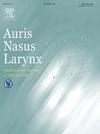外周面神经麻痹镫骨反射阳性预后不良相关因素的探索性研究
IF 1.5
4区 医学
Q2 OTORHINOLARYNGOLOGY
引用次数: 0
摘要
目的镫骨反射(SR)被广泛用于预测病毒性周围面神经麻痹(VPFNP)患者的预后,包括贝尔麻痹、带状疱疹(ZSH)和拉姆齐·亨特综合征(Hunt syndrome)。虽然SR阳性通常与治愈相关,但并不能保证所有患者都能获得这种结果。本研究旨在确定sr阳性VPFNP患者预后不良的预测因素,重点关注疾病早期可获得的临床数据。方法对某三级医院2013 - 2022年收治的230例sr阳性VPFNP患者进行回顾性探索性研究。预后因素包括初次就诊时的临床信息:疼痛、使用Yanagihara面部分级系统(y系统)评估的面瘫严重程度、诊断(贝尔麻痹/ZSH或亨特综合征)、临床表现(典型或非典型)以及SR检测的时间。典型的表现被定义为发病日期明确,孤立面神经麻痹,没有前庭耳蜗神经以外的颅神经受累的病例。非典型病例包括发病日期不清楚、复发性麻痹或额外的颅脑和其他神经缺损。治愈定义为发病6个月内柳原面部评分(Y-score)≥36分,不治愈定义为Y-score <;36. 神经电图(ENoG)和全身合并症,如MRI检测到的糖尿病(DM)和白质病变(WMLs),代表全身微血管功能不全,也进行了评估。结果230例患者中,治愈222例(96.5%),未治愈8例(3.5%)。不良预后的显著预测因素包括初次就诊时的疼痛(比值比[OR]:∞;95%置信区间[CI]: 5.21 -∞),初始Y-score≤10 (OR: 8.25;95% CI: 2.25-29.35),非典型临床表现(OR: 9.83;95% ci: 1.56-54.44)。重要的是,所有无疼痛的患者均被治愈。ENoG评分≤10%强烈预测不良预后(OR: 255;95% CI: 32.51-1548),尽管ENoG应在发病后7至10天进行,以获得最佳准确性。SR检测的时间对预后准确性没有显著影响,系统性合并症,如DM和WMLs,与预后没有显著相关性。结论尽管SR阳性,但伴有疼痛、严重麻痹(y评分≤10)或不典型表现的VPFNP患者出现不治愈的风险较高。将SR结果与基于简单患者评估的早期临床指标相结合,可以准确预测预后,改善患者咨询和治疗计划。本文章由计算机程序翻译,如有差异,请以英文原文为准。
Exploratory Study on Factors Associated with Poor Prognosis Despite Positive Stapedial Reflex in Peripheral Facial Nerve Palsy
Objective
The stapedial reflex (SR) is widely used to predict prognosis in patients with viral peripheral facial nerve palsy (VPFNP), including Bell’s palsy, zoster sine herpete (ZSH), and Ramsay Hunt syndrome (Hunt syndrome). While SR positivity is generally associated with cure, it does not guarantee this outcome in all patients. This study aimed to identify predictors of poor prognosis in SR-positive VPFNP patients, focusing on clinical data obtainable during the early stage of the disease.
Methods
A retrospective exploratory study was conducted on 230 SR-positive VPFNP patients treated at a tertiary hospital between 2013 and 2022. Prognostic factors included clinical information at the initial visit: pain, the severity of facial palsy assessed using the Yanagihara facial grading system (Y-system), diagnosis (Bell’s palsy/ZSH or Hunt syndrome), clinical presentation (typical or atypical), and the timing of SR testing. Typical presentations were defined as cases with a clear onset date, isolated facial nerve palsy, and no cranial nerve involvement beyond the vestibulocochlear nerve. Atypical cases included unclear onset date, recurrent palsy, or additional cranial and other nerve deficits. Cure was defined as a score of Yanagihara facial grading system (Y-score) ≥ 36 within six months of onset, while non-cure was defined as Y-score < 36. Electroneuronography (ENoG) and systemic comorbidities, such as diabetes mellitus (DM) and white matter lesions (WMLs) detected on MRI, which represent systemic microvascular insufficiency, were also evaluated.
Results
Of the 230 patients, 222 (96.5%) achieved cure, while 8 (3.5%) were classified as non-cured. Significant predictors of poor prognosis included pain at the initial visit (odds ratio [OR]: ∞; 95% confidence interval [CI]: 5.21–∞), an initial Y-score ≤ 10 (OR: 8.25; 95% CI: 2.25–29.35), and atypical clinical presentations (OR: 9.83; 95% CI: 1.56–54.44). Importantly, all patients without pain were cured. ENoG score ≤ 10% strongly predicted poor outcomes (OR: 255; 95% CI: 32.51–1548), although ENoG should be conducted seven to ten days after onset for optimal accuracy. The timing of SR testing did not significantly affect prognostic accuracy, and systemic comorbidities, such as DM and WMLs, showed no significant association with prognosis.
Conclusion
This study highlights that, despite SR positivity, VPFNP patients with pain, severe palsy (Y-score ≤ 10), or atypical presentations are at higher risk for non-cure. Combining SR results with early-stage clinical indicators based on simple patient evaluation enables accurate prognostic predictions, improving patient counseling and treatment planning.
求助全文
通过发布文献求助,成功后即可免费获取论文全文。
去求助
来源期刊

Auris Nasus Larynx
医学-耳鼻喉科学
CiteScore
3.40
自引率
5.90%
发文量
169
审稿时长
30 days
期刊介绍:
The international journal Auris Nasus Larynx provides the opportunity for rapid, carefully reviewed publications concerning the fundamental and clinical aspects of otorhinolaryngology and related fields. This includes otology, neurotology, bronchoesophagology, laryngology, rhinology, allergology, head and neck medicine and oncologic surgery, maxillofacial and plastic surgery, audiology, speech science.
Original papers, short communications and original case reports can be submitted. Reviews on recent developments are invited regularly and Letters to the Editor commenting on papers or any aspect of Auris Nasus Larynx are welcomed.
Founded in 1973 and previously published by the Society for Promotion of International Otorhinolaryngology, the journal is now the official English-language journal of the Oto-Rhino-Laryngological Society of Japan, Inc. The aim of its new international Editorial Board is to make Auris Nasus Larynx an international forum for high quality research and clinical sciences.
 求助内容:
求助内容: 应助结果提醒方式:
应助结果提醒方式:


